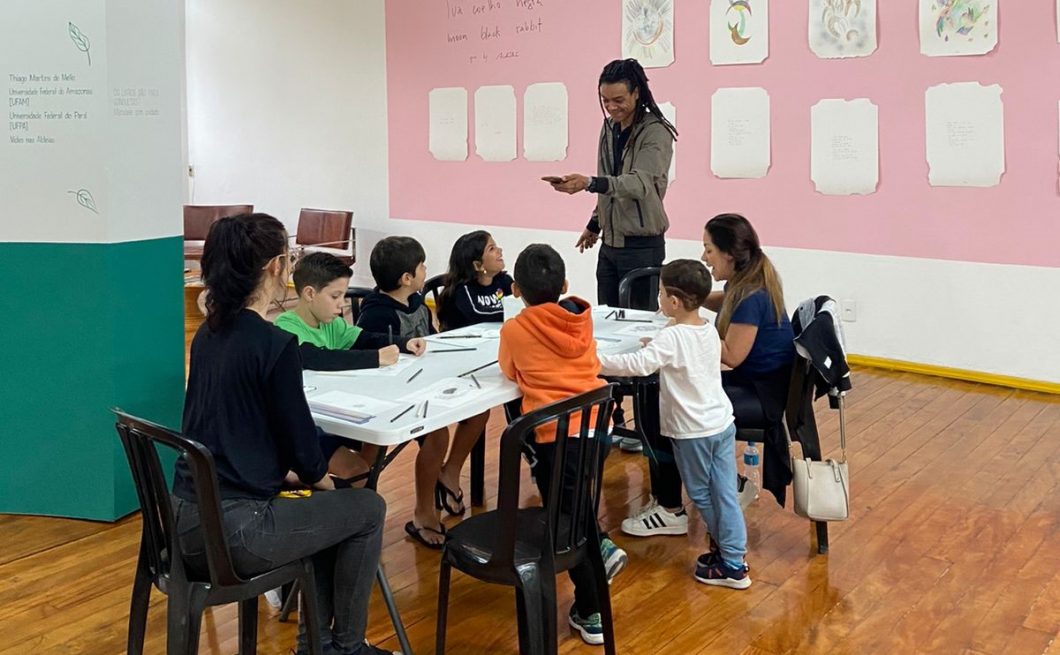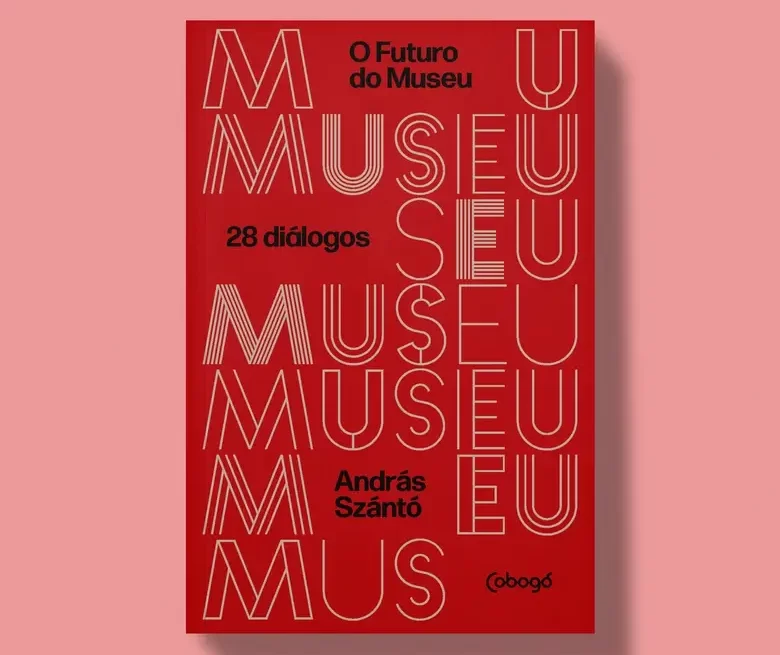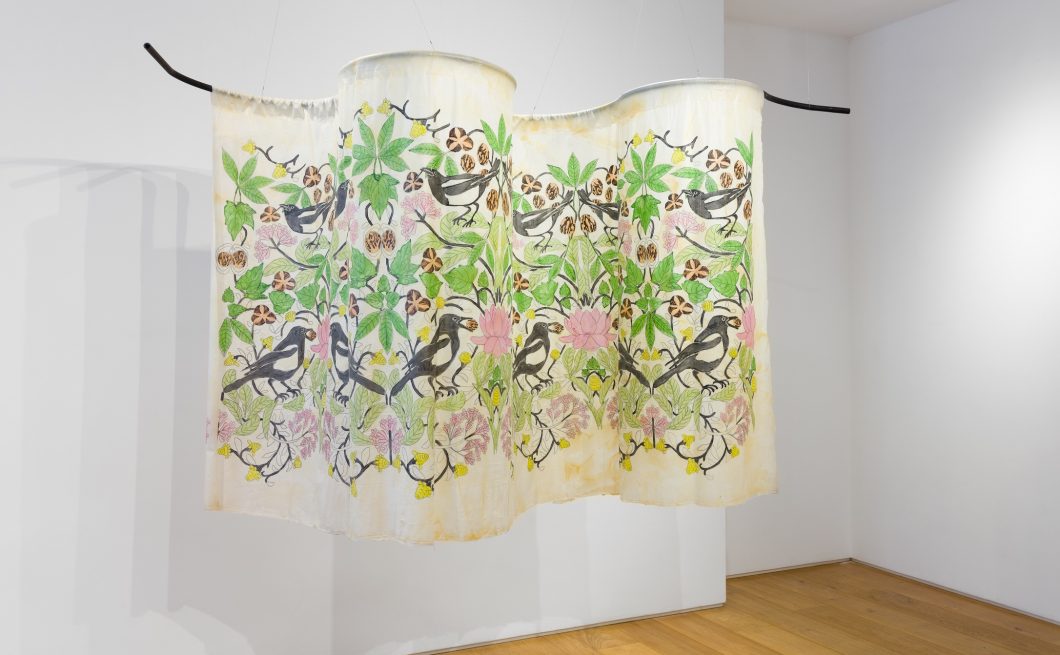Interview: Marcela Cantuária talks about the projects carried out in partnership with Inclusartiz
Currently on display at Sesc Pompeia with the solo exhibition Proposals for Re-enchantment, an artist from Rio de Janeiro recalls the four projects he carried out with the institute this year
In October 2022, artist Marcela Cantuária, from Rio de Janeiro, opened to the public at Sesc Pompeia, in São Paulo, the individual exhibition Proposals for Re-enchantment, part of the project Ofício: Mancha (Office: Stain). The show features two works developed at Inclusartiz Cultural Center in September, as part of our open-studio program: “Sweet Campfire” and “A Proposal for Re-enchantment”. During the two weeks of the paintings’ production, the Institute’s team and our visitors were able to follow closely the works’ realization, which enchant for their grandeur and richness of details.
“I was able to use the studio space in Gamboa to carry out two large works, on a non-domestic scale. This for me is something very valuable, because I can further develop the characters and even the research,” she says.

This is the fourth time that Cantuária’s production intersects with Inclusartiz. Earlier this year, the Institute invited her to paint walls and facades on the main streets of the city of Cajueiro da Praia, on the coast of the State of Piauí, as part of an initiative that aimed to draw attention to the preservation of the manatee, a symbol of that region. In February, her unpublished work “The Invocation of the Past at the Speed of the Present” was part of the ARCO circuit, the International Arts Fair in Madrid. Especially created for the event, the painting was on display at CentroCentro, a cultural space located in the Cibeles Pallace, headquarters of the Spanish capital’s City Council, where Cantuária was in artistic residency promoted in partnership with Inclusartiz.
This year, the artist also took part in the first edition of the Club of the 25 – a program for the acquisition of contemporary art works launched in commemoration of the institute’s 25th anniversary – with the set of drawings “The Eternal Return,” alongside four other artists who are part of our history.
Check out the interview with Marcela Cantuária below.
Your partnership with Instituto Inclusartiz began earlier this year, when you were invited to develop the environmental preservation project “Murals – Cashew and Manatee,” on the coast of Piauí, which also had the active participation of local residents. How was that work carried out?
It was a very unifying experience, in the sense of seeing art through a collective prism, something that can be made by several hands and, above all, together with the local community. Therefore, for me it was a very enriching experience. We had exchanges, not only with the workshops’ participants, which in this case were the local children, but also with their mothers, with government agencies, and with complete support from all. We were very well articulated. It is also a way of using art to raise awareness on environmental issues. It was one of the coolest projects I’ve ever done with the Institute. It was amazing.


This year, you also spent a season in artistic residency in Spain, which culminated in your participation in ARCO, the International Arts Fair in Madrid. How do you rate this international experience?
It was very important, because in my research I usually work on the history of peoples from a materialist perspective, which would be to understand the people’s situation, what their material conditions are, who is in charge and who is obeying. So, being in Madrid, thinking from a materialist perspective, I was able to see the power relationships between Europe and the American continent, more specifically Hispanic America. For me, it was fundamental to understand those issues, to understand where that power epicenter came from. I highly value any international experience, because it puts me in contact with other cultures, with other languages, so it’s also an exercise for my creativity and a world reading. The eyes need to read the world, and this as a live experience is something else, even more so in Europe, where we see the history of art and the Old World. It was important for me, as a painting student, to be able to be there without any filter, seeing the works that I knew through books during college.

More recently, Inclusartiz invited you to join the Club of the 25. What was it like to receive this invitation?
Everything related to the idea of multiple is a challenge for me, so when I received this invitation I didn’t really know how to respond. I ended up accepting it because it was a great opportunity to show a very old production of mine, from at least ten, twelve years ago, which I developed very early in college with my sketchpads, when I still had no means of painting large canvases. I used a lot of sketchpads and they went up and down with me. It was really important, because I actually felt like I was opening a diary. It’s a very intimate thing. My references that are repeated today and that remain within me are more muscular, perhaps – I can’t say –, but it was super important to work on the idea of eternal return, this thing of going back home. It is as if those sketchbooks had a beginning, a middle and an end. They condense a lot of my unconscious there. It was very cool, because anyone who knows only my recent work, from 2018 until now, which was when I exhibited at MASP in São Paulo, has never seen my sketchbooks, right? It was interesting for people to see the work behind it, which is something that has more body than we imagine.

In October, you opened the individual exhibition Proposals for Re-enchantment in São Paulo. Please, talk a little about the show development. How did the invitation to exhibit at Sesc Pompeia come about?
I received the invitation in 2019 through Bárbara Iara, the person responsible for education and projects at Sesc. She saw my exhibition at Hélio Oiticica, was delighted with the work and invited me, but then the pandemic came and everything was sort of upended. The invitation was reinforced by Inclusartiz, through a dinner promoted by Frances Reynolds, in which we sat down with Bárbara Reis, an influencer within Sesc. There we tied the project up. It was important because I felt supported, I think it would take longer to come about if it weren’t for the Institute’s support. Especially because the way it happened was also very important to me, because I was able to use the studio space at Gamboa (Inclusartiz headquarters in Rio de Janeiro) to carry out two large works, on a non-domestic scale. This for me is something very valuable, because I can develop more the characters and even the research. I had the support of the Institute to reconnect with Sesc Pompeia and to have a studio space to create two of the sixty works that are displayed.


As you have explained, two of the works in this new exhibition were produced at Inclusartiz Cultural Center. How was the experience of creating in an open studio with public following?
It was interesting, because it is really nice to paint there, it’s a great space, it’s beautiful, and you feel good. The public is also very kind, generous, and I am an artist who likes to be in contact with the public. For me it’s always a pleasure, it was great.

These two works – Sweet Campfire and A Proposal for Re-enchantment – are large-scale paintings that portray and honor important women in the political and cultural history of Latin America. What do they stand for?
In “Sweet Campfire”, I brought the image of two leaders who fought for the environmental cause, Marli Medeiros and Berta Cáceres. Marli Medeiros is a Brazilian from Porto Alegre, a black woman who fought alongside women subjugated by drug traffickers in the village where they lived. Marli organized those women, created the largest recycling factory in the south and became a point of reference. From this union between them, from this sense of community that was formed, they created kindergartens and schools for their children. It was a very beautiful thing.
Berta Cáceres is the author of the sentence written at the foot of the painting: “There is no alternative for us but fighting”. It is the second time that I portray Berta, who was a leader of the Lenca people in Honduras. She blocked the arrival of the Siemens company in her territory, because it would pollute many rivers, and it is also a trait of environmental racism that the people of South America, Central America and other parts of the world undergo. Berta Cáceres is very dear to me. She has a really inspiring life story. She founded COPINH, the Civic Council of Popular and Indigenous Organizations of Honduras, and was brutally murdered under the cover of the Honduran government because of the blockade they made against Siemens. In the end, the pen that counts belongs to the powerful, but Berta went all the way and she was murdered one day before her birthday, on her doorstep.
To this day, her murderer is not known. Anyway, it is a case very similar to that of Marielle, in Rio. I remember that when I learned about Berta’s story, I thought a lot about Marielle Franco and how these stories repeat themselves. I chose to place both of them above on the painting, looking down on a group gathered around a campfire. The idea was to bring an image of collectivity, of welcome. And those women are the guides to light our path.

Curator Aldones Nino has closely followed your work since the beginning of his partnership with the Institute, and has played an important part in the development of the projects mentioned above. How does this artist-curator relationship work?
My relationship with Aldones precedes the partnership with the Institute. In addition to our friendship, he is also someone I respect a lot for his ideas, the way he elaborates thoughts on painting, on art, on art history. He is someone who walks with me for a long time. This relationship takes place through exchanges of references. If there is a story or an image that catches my attention, I take it to him, and he returns it with another perspective or additional information. The exhibition that took place in Madrid, I owe him a lot for it. The fact that he studied history was a great support for me, in research, the history of the Americas, Queen Isabel, the maritime expansion… Anyway, much of this exchange took place through Aldones. I have counted on him for many years and I intend to keep counting.

What are your next steps? Do you have any projects in view for this year? What are you planning for 2023?
In 2023, I have a solo exhibition at the Pérez Art Museum in Miami, where I am now, in March. I have also some projects, still open.





